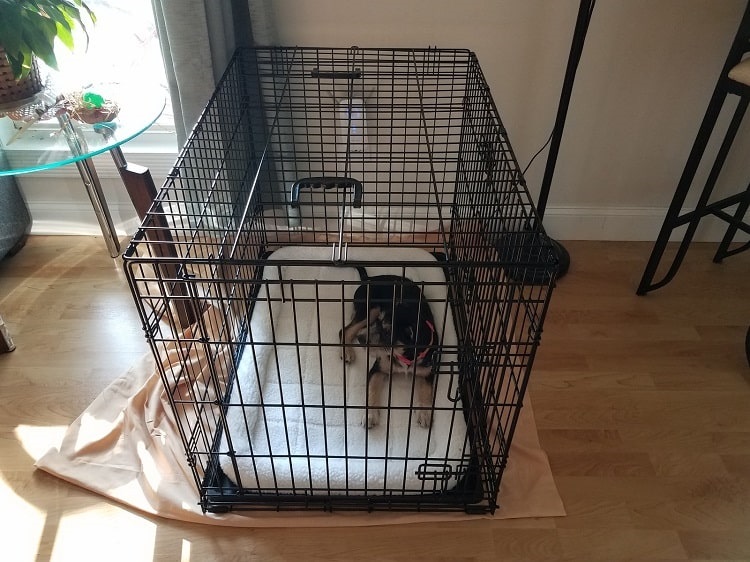As a veterinarian, many pet owners ask me why they should consider crate training and how to crate train a puppy. Crate training is an excellent way to keep your puppy from getting into trouble while you are out of the house. A crate trained puppy will not be able to chew up your couch, go counter surfing, or have accidents in the house while you are gone. If done correctly, the crate will be seen by your puppy as a safe and comforting place, which may reduce their anxiety while you are gone.
This article will discuss the best way to crate train a puppy and the keys to crate training a puppy.
The Best Way To Crate Train a Puppy
Step 1: Crate Orientation
The first step in crate training a puppy is to let your puppy become acquainted with the crate. Put soft blankets within the crate to make it look inviting. Leave the crate open at all times and let your puppy explore the crate. Never try to force your puppy into the crate. You can try throwing some treats into the crate to see if your puppy will enter the crate. Once your puppy seems eager to go into the crate on their own, you can move to step 2.
Step 2: Crate Playtime
Try playing with your puppy in the crate.1 Throw his favorite toy into the crate or play tug of war with him. You may even consider buying your puppy a few new toys to play with in their crate. At this point, you want your new uppy to think the crate is a fun place to be.
Step 3: Crate Mealtime
Next, begin to feed your puppy meals in the crate. In the beginning, do not close the door to the crate during mealtime. Keep the crate door open so your puppy can still come and go as they please. Once your puppy seems content with the crate, you can begin to close the crate door during mealtime and open up the crate just before your puppy is done eating.
Step 4: Crate Trial
Your puppy should now associate the crate with food, treats, playtime, and toys. If your puppy still seems to enjoy the crate, try a trial run. Get several of your puppy’s favorite treats or chew toys and place them in the crate. After your puppy enters the crate, close the crate door. Leave your puppy in the crate for 5 to 10 minutes then let them out. If they begin whining, try not to let them out until they stop whining. If they still seem content with the crate trial, begin to lengthen the period of time in the crate to 20 to 30 minutes. Slowly work your way up to 1 to 2 hours.
Step 5: Crate Time!
At this point, you have moved slowly with the crate training process, and your puppy should think that the crate is a safe and fun place to be. You can now try to leave your puppy in the crate for 3 to 4 hours while you are out of the house. Remember that puppies have small bladders so you shouldn’t leave them in the crate for any more than 3 to 4 hours at a time.
Keys To Crate Training a Puppy

Be Patient
Many pet owners ask me, “How long does it take to crate train a puppy?” When crate training a puppy, you must be patient. Crate training can take weeks to months and will not work if rushed. The training process should be done gradually because if you move too quickly through the steps, your puppy could become frustrated and start to associate the crate with a bad place. Remember to stay positive and be patient!
Do Not React To Whining
Should you ignore a puppy whining in a crate? Yes, if your puppy is whining, do not scold them or let them out of the crate. Any attention is good attention for a puppy, so by scolding them you are actually making the problem worse. Try to ignore the whining and only let them out of the crate when they have stayed quiet for 10 to 15 seconds.
Remove Any Collars or Harnesses
If you use a collar or a no slip harness for dogs and want to leave your puppy in a crate unattended, make sure you have removed their collar or harness. These things can get caught within the crate grating, and I have heard of cases where puppies have been strangled to death because their collar got caught in the crate.
Do Not Punish by Using the Crate
The Humane Society of the U.S. recommends never using crating as a punishment for your dog.2 If your puppy associates the crate with a negative experience, they will not want to use the crate at all.
Choose the Right Crate
You may be wondering how to choose a crate for your puppy. You will want to find a sturdy crate that can not be chewed up by your puppy. I usually recommend a metal crate when crate training a puppy. You can also consider
You will want the crate to give your puppy a little wiggle room, so be sure the crate is large enough for them to easily move around and stretch. We have resources for determining how big a dog crate should be, like our dog crate size chart.
Additionally, you can also consider using an indoor dog house or an outdoor dog kennel, depending on your pup’s needs.
Keep It Short
You may also be wondering how long you can leave an 8 week old puppy in a crate. Ideally, to avoid accidents, you should never leave your puppy in the crate for more than 4 hours at a time. Puppy bladders are extremely small, so it can be tough for them to go longer than 4 hours without going to the bathroom. As your puppy gets older, you can begin to leave them in the crate longer, but at less than 8 weeks of age, I usually recommend letting them out at least every 3 to 4 hours.
Consult with Your Veterinarian and Trainer
If you are struggling with crate training a puppy, remember to consult with your veterinarian and trainer. Other tips and techniques may be recommended for crate training your puppy. Some trainers may instruct you to use a training collar. Although in general, positive reinforcement is better for crate training a puppy than using a training collar because you will want to be sure your puppy associates the crate with positive experiences.3 In addition, I do not recommend training collars for puppies under 6 months of age.
Article Sources
Pet News Daily uses only high-quality sources, including peer-reviewed studies, to support the facts within our articles. Read our editorial process to learn more about how we fact-check and keep our content accurate, reliable, and trustworthy.
- Sharpe S. How to Crate Train Your Dog in 9 Easy Steps. Akc.org. Published December 23, 2019. Accessed February 28, 2021.
- The Humane Society of the United States. Crate training 101. Humanesociety.org. Accessed February 28, 2021.
- Todd Z. Positive Reinforcement is More Effective at Training Dogs than an Electronic Collar, Study Shows. Avsab.org. Published August 17, 2020. Accessed February 28, 2021.

